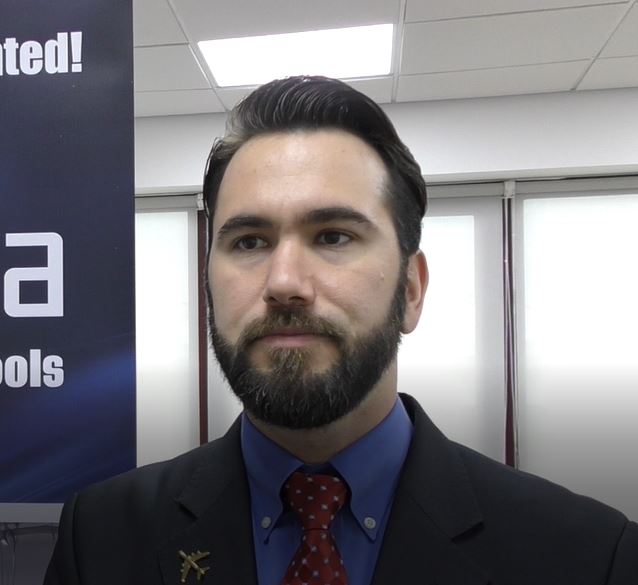Cutting a path through carbon

Now widely used on aircraft programmes, carbon fibre composite materials present distinct machining challenges for manufacturers. Ed Hill learns how rotary tool specialist Kyocera SGS has developed its products to meet these challenges.
Carbon fibre reinforced plastics (CFRP) have many qualities that mean they have been widely adopted in the aerospace sector. Firstly – and most importantly for the OEMs aiming to make aircraft as light and fuel efficient as possible – they are lightweight but with very high strength properties. Added to this are other benefits, such as resistance to fatigue, corrosion, impact wear and thermal stability.
However, many of these beneficial characteristics also make them harder to predict when being machined by cutting tools. Carbon fibre materials are made up of layers of fibre and resin. The configuration and orientation of the fibre embedded within the resin gives the material its particular strengths meaning that often a particular combination of resin and fibres is designed for a particular application on the aircraft, whether that be part of an engine nacelle, wings or the fuselage.
In some instances, both metallic and composite materials can be combined. Either in layers in what are known as stack materials or as part of a matrix. There are also honeycomb style substances and composite materials consisting of very tough fibres such as aramid.
These challenges mean that cutting tool manufacturers have had to design tools made of particular substrates, geometries and coatings to machine composites as efficiently as possible as traditional drills and mills for cutting metals are simply not suited to carry out the job.
Countering the splits
Probably the most common problem found when milling or drilling CFRP is delamination. Because the material is a made up of layers of resin and fibre, delamination can occur as the tip of the tool enters the material as it cuts through it and particularly as it exits it. Anyone who has drilled a hole in wood will be familiar that as the drill comes through the back surface it has a tendency to tear away at the material leaving a rougher edged hole on the exit (wood like CFRP is made up of fibres as well after all).
Other problems that can occur also include fibre breakout meaning that the surface finish of a hole can be ragged and frayed, cracks and heat build-up around the cutting area. Carbon fibre also happens to be particularly abrasive meaning wear of the cutting edge of the tool is also be increased. This means that diamond type materials are often chosen as the best medium for cutting as opposed to carbide because of their exceptional hardness.
Kyocera SGS is one of the world’s largest manufacturers of solid carbide rotary cutting tools. Its composite range offers carbide tools either coated with its Ti-NAMITE B, (Titanium DiBoride) coating and (Crystalline Diamond) Di-NAMITE coating. It can also manufacture diamond edged tools made with Polycrystalline (PCD) and chemical vapour deposition (CVD), brazed onto the tool. These diamond-edged tools are often manufactured as specials for a particular application.

“Our first option of tools for cutting carbon composite would be our carbide tools, coated with Ti-NAMITE B and then our diamond Di-NAMITE coated ones,” comments the cutting solutions provider’s diamond and laser machining technologist, Andreas Goldberger. “However, Kyocera SGS not only make cutting tools, we also analyse the whole cutting process to optimise it.
“This means PCD and CVD tools can be manufactured depending on the application. Our CVD tools (which offer pure diamond as the cutting edge) are processed with laser technology to guarantee a sharper and more consistent cutting edge. Lasers also allow us to incorporate more geometries onto the cutting edge as chip breakers etc. Importantly all of our carbide composite range can be offered with Ti-NAMITE B or Di-NAMITE coatings.”
All of Kyocera SGS carbide composite range of tools can be coated to offer better cutting and longer tool life, but the one for milling would be its Series 29 PCR (Plastic Composite Router) with the option of the Di-NAMITE crystalline diamond coating. For drilling operations, an example would be its Series 120 drill tools, which also have the Di-NAMITE coating.
Goldberger continues: “The biggest issue when machining composites is that each manufacturer’s material is a special type which makes everyone different and challenging. Finding a sole geometry or coating that works on all of these materials is difficult. Our assessment of the application will determine the best tools to apply. For example, on many occasions carbide tools may work better than diamond edged ones, especially where vibration is present. Stacked materials also create additional challenges when being machined.
“The major advantage of diamond tools, both PCD and CVD, is tool life. Compared to carbide tools, diamond is a heat absorbing material, removing the heat from the surface. The speeds and feeds are very similar to carbide tools but in terms of delamination, the sharp cutting edges will last longer and therefore cut better.”
One feature of carbide diamond coated tools is that they can be re-sharpened after the coating has been applied, which increases the shearing capabilities of the tool.
Goldberger explains that when it comes to PCD and CVD cutting tools, because of their extreme hardness, edge geometries are generally not as complex as other cutting tools. This is because current laser cutting technology is limited, however, improvements are constantly being made in this area.
And new cutting tool geometries which can have benefits for machining composite materials are being developed all the time, whatever the tool’s composition. An example is Kyocera SGS’ 120 Composite drill. This drill features an eight facet double angle design which creates four cutting edges along the drill point. This is said to help minimise delamination at the hole entry and exit and improve the surface finish. Again, the addition of the Di-NAMITE coating extends tool life.
Making it stable
As with any machining operation a major factor in carrying out successful milling or drilling is not just the cutting tool itself. Effective clamping or fixturing of the workpiece is vital to create stability but this is not easy if the CFRP structures being worked on are large as is often the case in aerospace.
Jose Ucar, EU marketing and business development manager at Kyocera SGS, says: “The major problem that can occur for diamond edged tools is that the fixturing of the workpiece is not rigid enough, which generates vibration, damaging the cutting tools much quicker as opposed to a carbide tool, so optimum clamping is always needed.”

With ramp up rates, particularly for civil aircraft increasing all the time the industry is keen to introduce as much automation as possible. This means that drilling operations that may have been carried out manually in the past are increasingly being performed by robots and other automation systems. This means the process as well as being faster is more consistent and repeatable and addresses the rigidity problems mentioned before.
“If the process is not stable, then it is difficult to apply CVD and PCD tools. As robot arms are becoming more popular this improves repeatability and positively affects tool life as robot drilling tends to be more stable,” adds Ucar.
As resins and fibres, such as biofibres, with different chemical formulas are being developed all the time, then new tools will also have to be developed to machine and drill them as efficiently as possible. Their increasing use in industries such as automotive and wind energy has also become a big driver in their development. However, it’s the entire machining and drilling process that needs continual improvement not just the cutting tool.
Ucar concludes: “Our main research when it comes to machining composites where PCD and CVD tools can be applied focuses on three aspects: developing CVD drills, CVD end mills and in our manufacturing processes using laser technology, but we also need more stability and continued improvements to the clamping and fixturing.”












